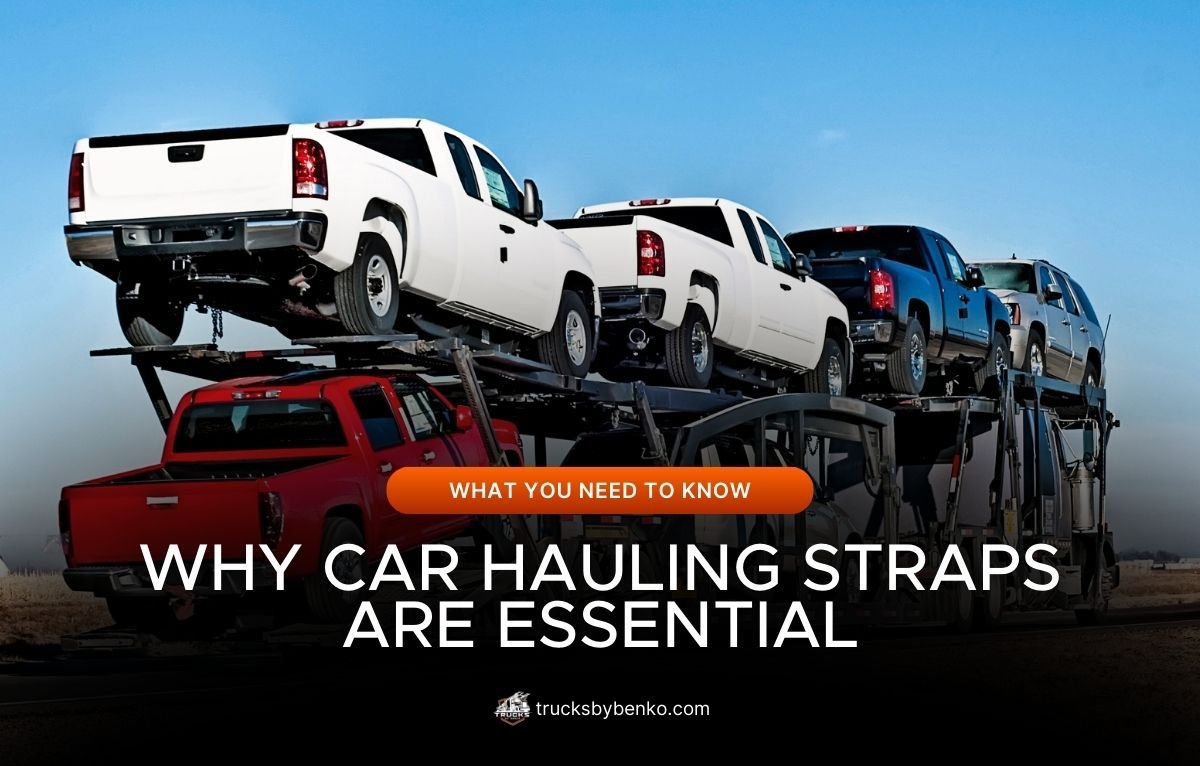Why Car Hauling Straps Are Essential for Every Transporter

One of the greatest worries of car owners when transporting their vehicles is safety precautions.
When transporting vehicles from one point to another, especially across towns or the country, it is important to ensure they are securely fastened to prevent damage. This is where car hauling straps come in.
Car hauling straps are often overlooked but are indispensable in the world of vehicle transport. In this blog, explore this simple tool’s importance to the industry.
Why Car Hauling Straps Became a Necessity
In the early days of vehicle transportation, securing cars for transit was a challenging and often risky task.
Before the introduction of modern car hauling straps, transporters relied on chains, ropes, and other rudimentary fastening methods.
However, these alternatives often had significant downsides.
The need for a more secure and adaptable solution grew as vehicles became heavier, more expensive, and more diverse in size and shape.
Car hauling straps quickly emerged as the best option, offering:
- Better grip and tension control – Unlike chains and ropes, straps can be tightened securely without causing damage.
- Flexibility for different vehicle types – Adjustable straps can accommodate a variety of car sizes and models.
- Minimized risk of damage – Soft yet strong webbing prevents scratches, dents, and frame stress.
Today, car hauling straps are a standard requirement in vehicle transport, ensuring that cars stay firmly in place, regardless of road conditions.
Previous Materials Used Before Car Hauling Straps
Before the widespread adoption of car hauling straps, transporters used several methods to secure vehicles.
While they served their purpose at the time, they lacked the effectiveness and reliability of modern straps.
Here are some of the materials used before:
Chains
- Chains were one of the most commonly used tools for securing vehicles in transport. While strong and durable, they had several downsides:
- They were heavy, making them difficult to handle.
- Metal-on-metal contact often led to scratches and dents on the vehicle.
- They lacked flexibility, making it challenging to secure different car sizes properly.
Ropes
- Ropes, particularly made of natural fibres like hemp, were also used in the past. However, they were not an ideal solution because:
- Ropes had low tensile strength, meaning they could snap under tension.
- Exposure to moisture led to fraying and weakening over time.
- They did not provide the tight grip needed to prevent vehicle movement.
Metal Brackets and Clamps
- Some transporters used metal clamps and brackets to hold vehicles in place. While they provided a rigid hold, they often:
- Damaged the car’s frame due to excessive force.
- Were not universally adaptable to different vehicle sizes.
- Required manual installation, which was time-consuming.
The introduction of high-strength polyester webbing straps revolutionized the industry by combining strength, flexibility, and ease of use.
Unlike chains and ropes, these straps distribute tension evenly, preventing damage while keeping vehicles securely in place.
Why Car Hauling Straps Matter
You’ve packed the truck, set up your vehicle on the trailer, and checked everything twice. Now, it’s time to secure the car for the journey. This is where car-hauling straps take centre stage.
These heavy-duty, high-tensile straps are designed to hold vehicles securely in place during transport, ensuring they remain stable on the trailer even during bumpy rides or sharp turns.
Without them, you risk the car shifting, causing damage to the vehicle or even worse, creating an accident.
Car hauling straps are designed to prevent these risks by tightly securing your car, giving you peace of mind no matter how far your journey is.
Types of Car Hauling Straps
Car hauling straps are a must for securing vehicles during transportation. These prevent movement and ensure safety when moving vehicles.
Because there are different types of vehicles and transport setups, a variety of straps are also available in the market.
Below are some of the most common types of car hauling straps:
Wheel Straps
Wheel straps secure the vehicle by its tyres, providing a stable and effective hold without putting pressure on the frame. They come in different variations:
- Over-the-Wheel Straps – These straps wrap over the top of the tyre and anchor to the trailer’s tie-down points. They provide strong lateral support and are ideal for flatbed trailers.
- Lasso Straps – A loop-style strap that wraps around the wheel and tightens with a ratchet or winch. These are versatile and work well with different trailer configurations.
- E-Track Wheel Straps – Designed specifically for trailers equipped with an E-track system, these straps secure the vehicle’s wheels to prevent shifting during transit.
Axle Straps
Axle straps are designed to wrap around the vehicle’s axle or suspension components and connect to ratchet straps. This hauling strap type provides a secure hold without stressing the vehicle’s frame. This type is perfect for transporting delicate vehicles like race cars, classic cars, and low-clearance vehicles.
Ratchet Straps
Ratchet straps are commonly used in combination with other securing methods. These heavy-duty straps feature a ratcheting mechanism that allows for precise tension control, ensuring a tight and secure fit.
They can be used with wheel straps, axle straps, or frame tie-downs.
Tow Straps & Recovery Straps
Tow and recovery straps are designed to pull vehicles rather than secure them for transport. Typically made of heavy-duty nylon or polyester, these straps offer some elasticity to absorb shocks when pulling a stuck or disabled vehicle.
V-Straps & Bridle Straps
V-straps and bridle straps are commonly used in tow trucks and wrecker services. These straps feature multiple connection points, distributing weight evenly and reducing stress on a single attachment point. They are ideal for pulling vehicles onto a tow truck bed.
E-Track & L-Track Straps
E-track and L-track straps provide adjustable securing options for enclosed trailers or custom transport setups. These straps work with rail systems installed on the trailer floor or walls, allowing for flexible and secure vehicle tie-downs.
What Makes Car Hauling Straps So Effective?
Superior Durability
Car hauling straps are built to withstand harsh conditions. Made from strong materials such as polyester webbing, they can handle extreme tension and resist wear and tear over time.
Whether you’re hauling a lightweight sedan or a heavy-duty truck, these straps are designed to endure the pressure of securely holding your vehicle throughout the entire trip.
Versatile and Adjustable
Every vehicle is different, so it’s important to have straps that can adapt to various car sizes and weights. Car hauling straps are highly adjustable, meaning they can fit a range of vehicle types, from compact cars to larger trucks.
Whether you’re hauling a classic car or a brand-new luxury model, these straps can be adjusted to ensure a snug and secure fit for any load.
Enhanced Safety
The primary purpose of car hauling straps is to enhance the safety of your transport. A securely fastened vehicle reduces the risk of accidents or damage, preventing the car from shifting or falling off the trailer.
Proper use of high-quality straps ensures that the car stays in place, regardless of road conditions.
How to Choose the Right Car Hauling Straps
The primary purpose of car hauling straps is to enhance the safety of your transport. A securely fastened vehicle reduces the risk of accidents or damage, preventing the car from shifting or falling off the trailer.
Proper use of high-quality straps ensures that the car stays in place, regardless of road conditions.
With so many options available, selecting the right car-hauling straps for your needs can feel overwhelming.
Here are a few tips to ensure you get the best straps for your transport needs:
- Check the Weight Rating: Make sure the straps you choose are rated to handle the weight of your vehicle. Always choose a strap with a higher weight capacity than your car to avoid any tension on the straps.
- Look for Quality Materials: Opt for straps made from durable, UV-resistant polyester. This material is designed to withstand both heavy use and the elements, so your straps will last longer.
- Adjustability: Choose adjustable straps that allow you to customize the fit, ensuring a secure hold on any car you’re transporting.
Cons of Using Car Hauling Straps
While car hauling straps are highly effective, they do have some drawbacks that transporters should consider.
Wear and tear over time
Car hauling straps, especially those made from polyester webbing, can degrade with repeated use, exposure to harsh weather, and constant tension.
Over time, they may fray or weaken, reducing their effectiveness and requiring frequent inspection and replacement to maintain safety.
Risk of improper use
If straps are not secured correctly, they can loosen during transport, allowing the vehicle to shift, which can lead to damage.
On the other hand, overtightening may put excessive strain on the car’s suspension or frame. Incorrect strap placement can also result in uneven weight distribution, making the vehicle less stable during transit.
Susceptible to environmental factors
While many high-quality straps are designed to resist UV rays and moisture, prolonged exposure to extreme weather conditions can weaken their fibres.
Straps that absorb moisture can become prone to mildew or mold, which can compromise their durability and performance over time.
Limited strength for heavy-duty applications
While they work well for most standard vehicles, they may not be sufficient for securing extremely heavy loads, such as construction vehicles or industrial equipment.
Chains are often preferred in these cases due to their superior strength and ability to handle greater weight capacities. If straps are used beyond their load rating, they can snap under pressure, posing a serious safety risk.
Need for frequent inspections and replacements
Unlike metal chains that can last for years with minimal maintenance, straps require regular inspection to check for fraying, cuts, or UV damage.
Any sign of wear means they must be replaced immediately to avoid failure, adding to the long-term costs for transporters.
Time-consuming
Unlike metal chains that can last for years with minimal maintenance, straps require regular inspection to check for fraying, cuts, or UV damage.
Any sign of wear means they must be replaced immediately to avoid failure, adding to the long-term costs for transporters.
Unlike metal chains that can last for years with minimal maintenance, straps require regular inspection to check for fraying, cuts, or UV damage.
Any sign of wear means they must be replaced immediately to avoid failure, adding to the long-term costs for transporters.
Conclusion
Car hauling straps have become an essential tool in vehicle transportation, offering a secure, flexible, and vehicle-friendly way to keep cars in place during transit.
Their durability, adjustability, and ability to prevent damage make them a preferred choice for both professional transporters and individuals moving vehicles.
Unlike chains, they provide a gentler but equally effective hold, ensuring the car arrives at its destination safely and in pristine condition.
However, like any tool, car hauling straps come with limitations. They require regular inspection and replacement, proper usage techniques, and careful attention to weight ratings to ensure safety.
Environmental factors such as moisture and UV exposure can degrade their strength over time, and for extremely heavy-duty applications, chains might still be the better option.
Additionally, securing a vehicle with straps can take time and effort, but the peace of mind they offer is worth the extra steps.
When weighing the pros and cons, the advantages of car hauling straps far outweigh their drawbacks—as long as they are used correctly and maintained properly.
Investing in high-quality straps, following best practices for securing vehicles, and conducting regular inspections will ensure that every transport is safe, efficient, and damage-free.
Whether you’re a seasoned car hauler or moving a single vehicle, the right straps will make all the difference in delivering a secure and stress-free transport experience.
